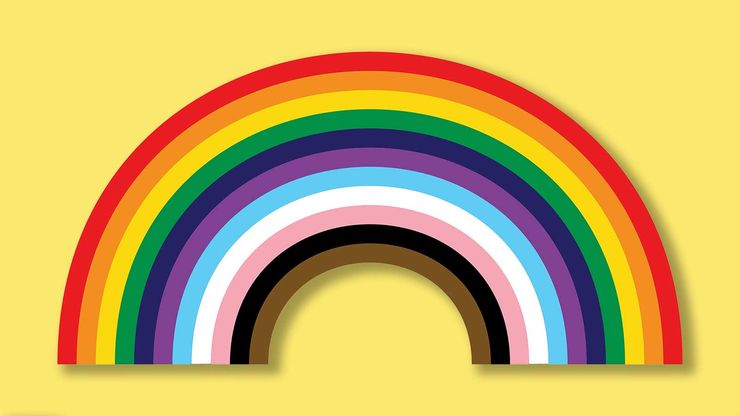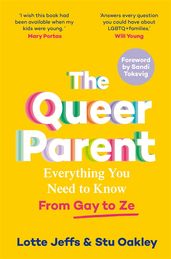10 tips for talking to children about sexual orientation
From discussing different types of families with young children to supporting older children questioning their own sexual orientation, here are some top tips for open, inclusive conversations from Lotte Jeffs and Stuart Oakley, authors of The Queer Parent.

Here, Lotte Jeffs and Stuart Oakley, authors of The Queer Parent, offer advice for parents of all and any sexual orientation, on how to discuss and answer children's questions about their own and others' sexuality in an inclusive, open, empathetic and age-appropriate way.
1. Create a world where your child doesn’t need to ‘come out’
As a young person, making a grand and definitive announcement about your sexuality is inevitably cringe-inducing. However open-minded or accepting you are as a family, your child is in a position where they feel they have to tell you how they identify and potentially contextualise or justify that sexuality in a way that someone who isn’t LGBTQIA+ simply never has to. If you can be conscious from when your child is very young of presenting heterosexual and queer relationships as equally possible and valid, you might just alleviate the pressure of a child needing to ‘come out’ at all. Perhaps when they’re fifteen and you yet again make a passing reference to "a future boyfriend or girlfriend", they may just say "girlfriend actually, Dad," and then that’s it – you know your daughter is queer without it needing to be a big conversation.
2. Integrate LGBT characters in play from an early age
Next time you’re dragged into an imaginary game with your child try suggesting that those two Sylvanian bears are the baby’s mummies. Or maybe Ken is dating Ken, not Barbie. Heteronormative and gendered stereotypes start entering into children's consciousnesses from this early age so do your best to offer alternatives to imaginary family set ups, marriages and relationships in the weird and wonderful make-believe worlds they create with you. Because we have been conditioned to see gay relationships as hyper-sexualised in a way straight relationships are not, it can feel ‘inappropriate’ to suggest the princess in this game is brought back to life by a kiss from another princess rather than a prince, but you really have to challenge yourself on why that is.
‘Along with play, and conversation, sharing books that feature LGBTQIA+ storylines and characters is a great way of normalising them.’
3. Diversify your bookshelf. . .
Along with play, and conversation, sharing books that feature LGBTQIA+ storylines and characters is a great way of normalising them. When reading with your child, stop to ask questions and check in on their understanding. "The little girl in this book has two Dads, do we know anyone who has two Dads?" for example. As your child gets older and reads books to themselves, it’s still important that those YA novels include characters who are different from themselves. Life experience is limited when you’re a pre teen or teenager, so expanding their world and frame of reference with books that hero queer characters is the best way to foster empathy and understanding. If your child is LGBTQ or you think they might be, gifting them a book that explores queer themes is a quiet way of proving your allyship.
4. . . . then diversify your entertainment
Once your children start to get older try and make sure you are watching and listening to content that features LGBTQ+ people and storylines. Whilst age appropriate music, film and TV can be few and far between it is out there and it’s getting better. Have a young teenager? Maybe suggest you watch Heartstopper as a family one evening? Or seek out the Disney Pixar short Out, which is a beautiful animation about being gay. Support this content and whether your child is gay, straight or somewhere else on the queer spectrum, it will help build their understanding of the world that is around them. Remember, watching hours and hours of straight content doesn't make your child straight so the opposite won’t suddenly make them gay.
5. Maybe it is a phase, and that’s OK
One of the least supportive things a parent can say to an LGBTQIA+ child is "it’s probably just a phase." It sounds dismissive and thoughtless and implies that being queer is a blip on the journey to eventually ending up straight. So queer people have quite rightly been fighting against this notion that our sexuality is a passing phase and the result is that we now feel a desperate pressure to identify a certain way and then stick to that identity forever. As parents, it’s our job to make our children feel that they can be who they want to be and there is no judgement or expectation. Maybe they are adamant they are straight when they’re teenagers, but later explore same sex relationships. Maybe a teenager tells you they are asexual, or bisexual, or demisexual (google it!) but a year later tells you they identify completely differently. Go with the flow! We all shift and change throughout our lives and shouldn’t feel that the self we declare ourselves to be when we’re fifteen has to be the way we identify forever. Be understanding and supportive throughout your child’s journey of self discovery.
‘Without trying too hard to be the "I’m not a regular mom, I’m a cool mom” character from Mean Girls, think about how you can perhaps make your home a safe space for not only your child, but their friends too, especially when they start hitting teen years.’
6. Be open about your own sexuality
Creating a family safe space for talking about feelings, identity and sexuality starts with you. Being open about these subjects and how you have explored them throughout your life gives children permission to initiate those conversations themselves. Encourage them to ask you questions and show that it’s ok to be vulnerable. As they get older they may well have a whole lexicon of labels that are new to you (did you know there are over twenty different words to describe sexuality today?) If you have shared your experience and the ways in which things were different when you were their age, you’ve created a happy and non-judgmental environment to then ask your child questions and learn from them too.
7. Make your home a safe space
Without trying too hard to be the "I’m not a regular mom, I’m a cool mom” character from Mean Girls, think about how you can perhaps make your home a safe space for not only your child, but their friends too, especially when they start hitting teen years. We are not saying turn your living room into the HQ of your local Pride drop-in centre, but maybe consider a rainbow flag in your window all year round, not just for Pride. A simple gesture like this can go a long way. Your child might not be gay, but their friends could be, and they might not be lucky enough to have a parent like you. So make your home somewhere they feel accepted, loved and understood. Hell, even if you embarrass yourself, and your child, by proclaiming your love of RuPaul to their friends, it might just hit the right nerve for someone struggling.
8. Gay isn’t a dirty word
People seem to have an emotional reaction to words such as gay and lesbian, and that includes LGBTQ+ people themselves. Since having children it’s made us realise that these are words we didn’t feel comfortable saying around them. Why? For years Gay, lesbian, queer, trans have all been used in derogatory ways and that has built a ball of shame that lives inside many of us. But they are not dirty words. Embrace them. Use them and don’t be afraid to use it when describing different types of love and relationships. It’s time we normalised and celebrated these words.
‘Even with an emotionally intelligent parent such as yourself (you’ve already got our vote for reading this) it can be incredibly hard for a child to come out and work out their identity. Seeing your child hurt in this way can be hard, so don’t suffer in silence or feel like you should have all the answers.’
9. Lean on your queer friends
Sadly (for them) not everyone is lucky enough to have a queer person in their life. If you do then do your best, without forcing the matter, to have your children get to know them, especially when they become teenagers. Having role models or even just visible queers around them could make them feel seen. If you don’t have a good friend who is LGBTQ+ then perhaps you have a work acquaintance that is queer? Speak to them about your child. Most queer people know first hand how hard it can be to discover your identity when young (many of us are still trying!), and I’m sure would be willing to help a young person, or their parents, in some way. And can’t think of anyone around you that is gay? Well, you need to work hard on points 3 and 4, honey!
10. Don’t be afraid to ask for help
Even with an emotionally intelligent parent such as yourself (you’ve already got our vote for reading this) it can be incredibly hard for a child to come out and work out their identity. Seeing your child hurt in this way can be hard, so don’t suffer in silence or feel like you should have all the answers. Support such as the LGBTQ+ Switchboard can help you to help them. Also remind your children that they can always speak, via text if need be, to the likes of Childline or the LGBTQ+ Switchboard. Childline is a great neutral space to start from if your child hasn’t indicated to you they are LGBTQ+, and you don’t want to put words in their mouth before they’ve been able to figure it out themselves. Visit www.switchboard.lgbt and www.childline.org.uk
The Queer Parent
by Lotte Jeffs and Stu Oakley
This informative, funny and empowering book from the hosts of the award-winning podcast Some Families is the must-have parenting toolkit for the LGTBQ+ community, their friends, family and allies. 90% of queer parenting is just . . . parenting, but being LGBTQ+ when you’re a parent does bring with it a host of conundrums that mainstream guides – which tend to assume heterosexuality – do not address. Authors Lotte Jeffs and Stu Oakley spoke to dozens of experts and queer families, and this hugely-needed book is the product of those conversations and their own experiences of becoming parents through IUI and adoption respectively.
You may also be interested in these books for children and young adults
And you can find further inspiration with our pick of some of the great queer YA fiction out now.
For more advice discover the best parenting books.








